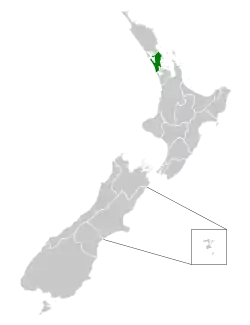Waitematā District Health Board
The Waitemata District Health Board (Waitemata DHB) is a district health board with the focus on providing healthcare to the area that used to be covered by North Shore city, Rodney District, and Waitakere City in New Zealand.
 Location of the Waitemata DHB (green) in New Zealand | |
| Formation | 1 January 2001 |
|---|---|
| Founder | New Zealand Government |
| Legal status | Active |
| Purpose | DHB |
| Services | Health and disability services |
Chairperson | Judy McGregor |
Parent organization | Ministry of Health |
| Website | www |
History
The Waitemata District Health Board, like most other district health boards, came into effect on 1 January 2001 established by the New Zealand Public Health and Disability Act 2000.[1]
Geographic area
The area covered by the Waitemata District Health Board is defined in Schedule 1 of the New Zealand Public Health and Disability Act 2000 and based on territorial authority and ward boundaries as constituted as at 1 January 2001.[2] The area can be adjusted through an Order in Council.[3]
Governance
The initial board was fully appointed. Since the 2001 local elections, the board has been partially elected (seven members) and in addition, up to four members get appointed by the Minister of Health. The minister also appoints the chairperson and deputy-chair from the pool of eleven board members.[4]
Current board (2019–2022)
| Member(s) | Affiliation (if any) |
|---|---|
| Judy McGregor (chair) | None (appointed) |
| Kylie Clegg | None (appointed) |
| Max Abbott | Health Board Action |
| Edward Benson-Cooper | Independent |
| John Bottomley | Independent |
| Chris Carter | Independent |
| Sandra Coney | Independent |
| Warren Flaunty | Health Board Action |
| Allison Roe | Independent |
| Renata Watene | None (appointed) |
| Arena Williams | None (appointed) |
Demographics
| Year | Pop. | ±% p.a. |
|---|---|---|
| 2006 | 481,614 | — |
| 2013 | 525,555 | +1.26% |
| 2018 | 586,335 | +2.21% |
| Source: [5] | ||
Waitemata DHB served a population of 586,335 at the time of the 2018 New Zealand census, an increase of 60,780 people (11.6%) since the 2013 census, and an increase of 104,721 people (21.7%) since the 2006 census. There were 193,440 households. There were 288,216 males and 298,119 females, giving a sex ratio of 0.97 males per female. Of the total population, 116,286 people (19.8%) were aged up to 15 years, 118,899 (20.3%) were 15 to 29, 272,202 (46.4%) were 30 to 64, and 78,948 (13.5%) were 65 or older. Figures may not add up to the total due to rounding.
Ethnicities were 65.3% European/Pākehā, 10.1% Māori, 8.6% Pacific peoples, 24.3% Asian, and 3.4% other ethnicities. People may identify with more than one ethnicity.
The percentage of people born overseas was 39.3, compared with 27.1% nationally.
Although some people objected to giving their religion, 49.5% had no religion, 36.0% were Christian, and 8.7% had other religions.
Of those at least 15 years old, 133,344 (28.4%) people had a bachelor or higher degree, and 59,322 (12.6%) people had no formal qualifications. The median income was $35,700. The employment status of those at least 15 was that 243,117 (51.7%) people were employed full-time, 67,515 (14.4%) were part-time, and 16,836 (3.6%) were unemployed.[5]
Hospitals
Public hospitals
- North Shore Hospital (36.7821018°S 174.7548627°E) in Takapuna has 663 beds and provides maternity, medical, geriatric, children's health, surgical, psychogeriatric and mental health services.[6]
- Waitakere Hospital (36.8702993°S 174.6280573°E) in Henderson has 283 beds and provides geriatric, children's health, surgical, mental health, maternity and medical services.[7]
- He Puna Waiora (36.7799065°S 174.7542401°E) in Takapuna has 35 beds and provides mental health services.[8]
- Elective Surgery Centre (36.782243°S 174.753698°E) in Takapuna has 30 beds and provides surgical services.[9]
- Wilson Centre (36.7998837°S 174.7858688°E) in Hauraki has 26 beds and provides physical and children's health services.[10]
Private hospitals
- Southern Cross Hospital North Harbour (36.7700676°S 174.7303662°E) in Wairau Valley has 59 beds and provides surgical and medical services.[11]
- Hospice North Shore (36.7750877°S 174.7264888°E) in Takapuna has 14 beds and provides medical services.[12]
- Helensville Birthing Centre (36.6753745°S 174.449034°E) in Helensville has five] beds and provides maternity services.[13]
- Wellsford Birthing Unit (36.2925215°S 174.5224384°E) in Wellsford has two beds and provides maternity services.[14]
Notes
- Rudman, Brian (13 February 2012). "Brian Rudman: Three health boards must marry and economise". The New Zealand Herald. Retrieved 3 May 2020.
- Public Health and Disability Act 2000, Schedule 1.
- Public Health and Disability Act 2000, Section 19.
- "District health boards". Ministry of Health. 12 February 2020. Retrieved 3 May 2020.
- "Statistical area 1 dataset for 2018 Census". Statistics New Zealand. March 2020. Waitemata DHB (02).
- "North Shore Hospital - Ministry of Health Profile". health.govt.nz. Ministry of Health.
- "Waitakere Hospital - Ministry of Health Profile". health.govt.nz. Ministry of Health.
- "He Puna Waiora - Ministry of Health Profile". health.govt.nz. Ministry of Health.
- "Elective Surgery Centre - Ministry of Health Profile". health.govt.nz. Ministry of Health.
- "Wilson Centre - Ministry of Health Profile". health.govt.nz. Ministry of Health.
- "Southern Cross Hospital North Harbour - Ministry of Health Profile". health.govt.nz. Ministry of Health.
- "Hospice North Shore - Ministry of Health Profile". health.govt.nz. Ministry of Health.
- "Helensville Birthing Centre - Ministry of Health Profile". health.govt.nz. Ministry of Health.
- "Wellsford Birthing Unit - Ministry of Health Profile". health.govt.nz. Ministry of Health.
References
- New Zealand Public Health and Disability Act 2000, Parliamentary Counsel Office, 2000, retrieved 3 May 2020
